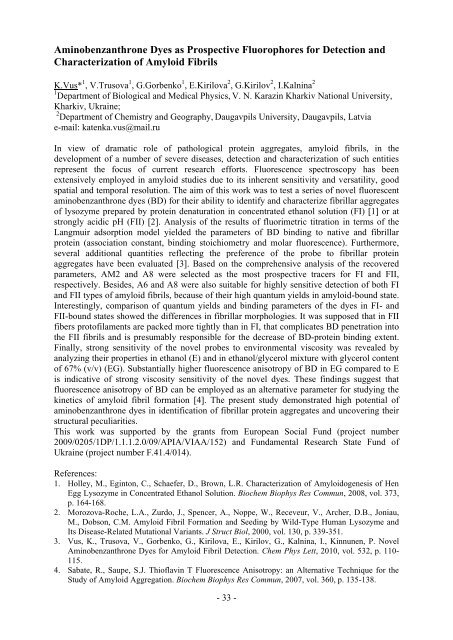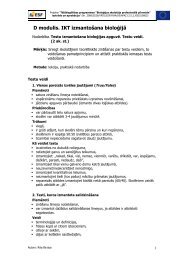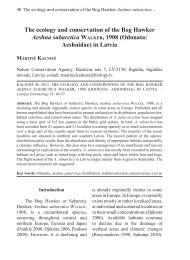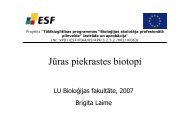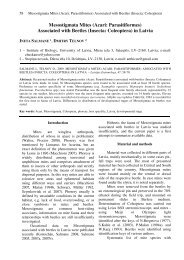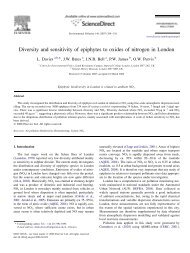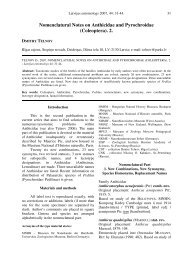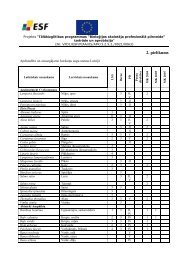Dissolved organic matter in water of Daugava river
Dissolved organic matter in water of Daugava river
Dissolved organic matter in water of Daugava river
You also want an ePaper? Increase the reach of your titles
YUMPU automatically turns print PDFs into web optimized ePapers that Google loves.
Am<strong>in</strong>obenzanthrone Dyes as Prospective Fluorophores for Detection andCharacterization <strong>of</strong> Amyloid FibrilsK.Vus* 1 , V.Trusova 1 , G.Gorbenko 1 , E.Kirilova 2 , G.Kirilov 2 , I.Kaln<strong>in</strong>a 21 Department <strong>of</strong> Biological and Medical Physics, V. N. Karaz<strong>in</strong> Kharkiv National University,Kharkiv, Ukra<strong>in</strong>e;2 Department <strong>of</strong> Chemistry and Geography, Daugavpils University, Daugavpils, Latviae-mail: katenka.vus@mail.ruIn view <strong>of</strong> dramatic role <strong>of</strong> pathological prote<strong>in</strong> aggregates, amyloid fibrils, <strong>in</strong> thedevelopment <strong>of</strong> a number <strong>of</strong> severe diseases, detection and characterization <strong>of</strong> such entitiesrepresent the focus <strong>of</strong> current research efforts. Fluorescence spectroscopy has beenextensively employed <strong>in</strong> amyloid studies due to its <strong>in</strong>herent sensitivity and versatility, goodspatial and temporal resolution. The aim <strong>of</strong> this work was to test a series <strong>of</strong> novel fluorescentam<strong>in</strong>obenzanthrone dyes (BD) for their ability to identify and characterize fibrillar aggregates<strong>of</strong> lysozyme prepared by prote<strong>in</strong> denaturation <strong>in</strong> concentrated ethanol solution (FI) [1] or atstrongly acidic pH (FII) [2]. Analysis <strong>of</strong> the results <strong>of</strong> fluorimetric titration <strong>in</strong> terms <strong>of</strong> theLangmuir adsorption model yielded the parameters <strong>of</strong> BD b<strong>in</strong>d<strong>in</strong>g to native and fibrillarprote<strong>in</strong> (association constant, b<strong>in</strong>d<strong>in</strong>g stoichiometry and molar fluorescence). Furthermore,several additional quantities reflect<strong>in</strong>g the preference <strong>of</strong> the probe to fibrillar prote<strong>in</strong>aggregates have been evaluated [3]. Based on the comprehensive analysis <strong>of</strong> the recoveredparameters, AM2 and A8 were selected as the most prospective tracers for FI and FII,respectively. Besides, A6 and A8 were also suitable for highly sensitive detection <strong>of</strong> both FIand FII types <strong>of</strong> amyloid fibrils, because <strong>of</strong> their high quantum yields <strong>in</strong> amyloid-bound state.Interest<strong>in</strong>gly, comparison <strong>of</strong> quantum yields and b<strong>in</strong>d<strong>in</strong>g parameters <strong>of</strong> the dyes <strong>in</strong> FI- andFII-bound states showed the differences <strong>in</strong> fibrillar morphologies. It was supposed that <strong>in</strong> FIIfibers prot<strong>of</strong>ilaments are packed more tightly than <strong>in</strong> FI, that complicates BD penetration <strong>in</strong>tothe FII fibrils and is presumably responsible for the decrease <strong>of</strong> BD-prote<strong>in</strong> b<strong>in</strong>d<strong>in</strong>g extent.F<strong>in</strong>ally, strong sensitivity <strong>of</strong> the novel probes to environmental viscosity was revealed byanalyz<strong>in</strong>g their properties <strong>in</strong> ethanol (E) and <strong>in</strong> ethanol/glycerol mixture with glycerol content<strong>of</strong> 67% (v/v) (EG). Substantially higher fluorescence anisotropy <strong>of</strong> BD <strong>in</strong> EG compared to Eis <strong>in</strong>dicative <strong>of</strong> strong viscosity sensitivity <strong>of</strong> the novel dyes. These f<strong>in</strong>d<strong>in</strong>gs suggest thatfluorescence anisotropy <strong>of</strong> BD can be employed as an alternative parameter for study<strong>in</strong>g thek<strong>in</strong>etics <strong>of</strong> amyloid fibril formation [4]. The present study demonstrated high potential <strong>of</strong>am<strong>in</strong>obenzanthrone dyes <strong>in</strong> identification <strong>of</strong> fibrillar prote<strong>in</strong> aggregates and uncover<strong>in</strong>g theirstructural peculiarities.This work was supported by the grants from European Social Fund (project number2009/0205/1DP/1.1.1.2.0/09/APIA/VIAA/152) and Fundamental Research State Fund <strong>of</strong>Ukra<strong>in</strong>e (project number F.41.4/014).References:1. Holley, M., Eg<strong>in</strong>ton, C., Schaefer, D., Brown, L.R. Characterization <strong>of</strong> Amyloidogenesis <strong>of</strong> HenEgg Lysozyme <strong>in</strong> Concentrated Ethanol Solution. Biochem Biophys Res Commun, 2008, vol. 373,p. 164-168.2. Morozova-Roche, L.A., Zurdo, J., Spencer, A., Noppe, W., Receveur, V., Archer, D.B., Joniau,M., Dobson, C.M. Amyloid Fibril Formation and Seed<strong>in</strong>g by Wild-Type Human Lysozyme andIts Disease-Related Mutational Variants. J Struct Biol, 2000, vol. 130, p. 339-351.3. Vus, K., Trusova, V., Gorbenko, G., Kirilova, E., Kirilov, G., Kaln<strong>in</strong>a, I., K<strong>in</strong>nunen, P. NovelAm<strong>in</strong>obenzanthrone Dyes for Amyloid Fibril Detection. Chem Phys Lett, 2010, vol. 532, p. 110-115.4. Sabate, R., Saupe, S.J. Thi<strong>of</strong>lav<strong>in</strong> T Fluorescence Anisotropy: an Alternative Technique for theStudy <strong>of</strong> Amyloid Aggregation. Biochem Biophys Res Commun, 2007, vol. 360, p. 135-138.- 33 -


